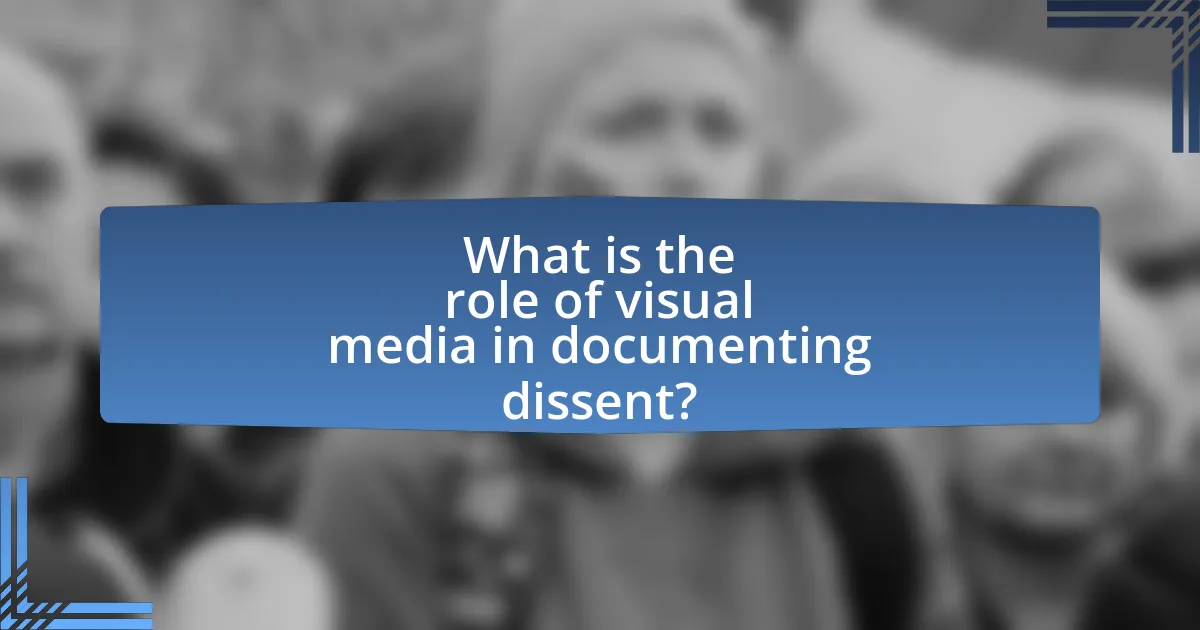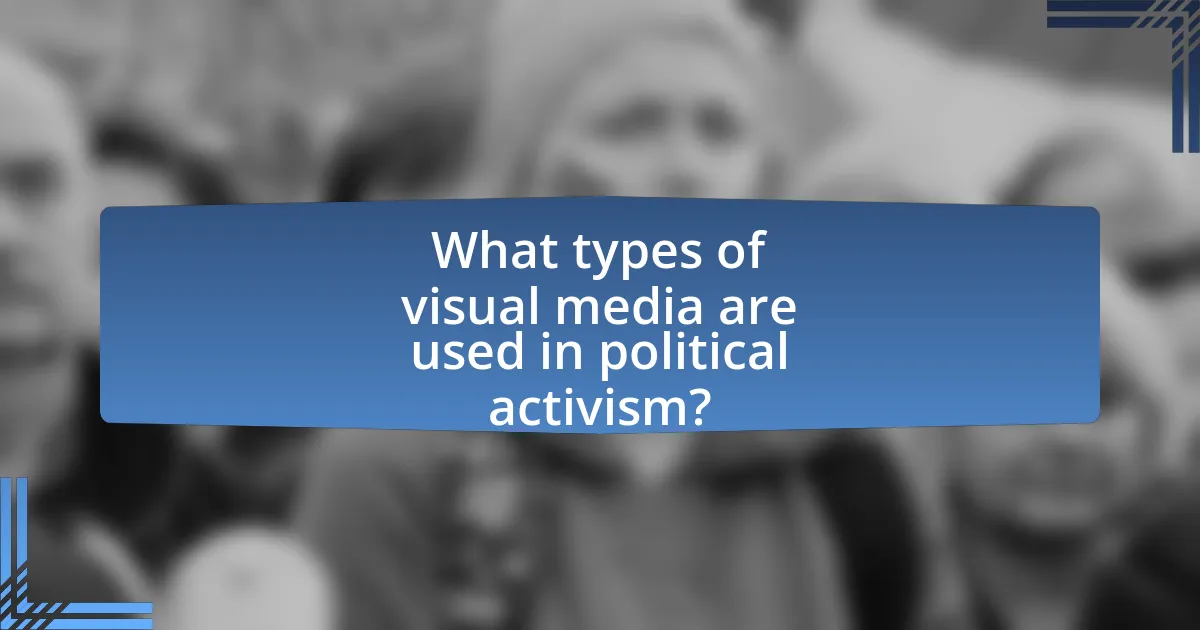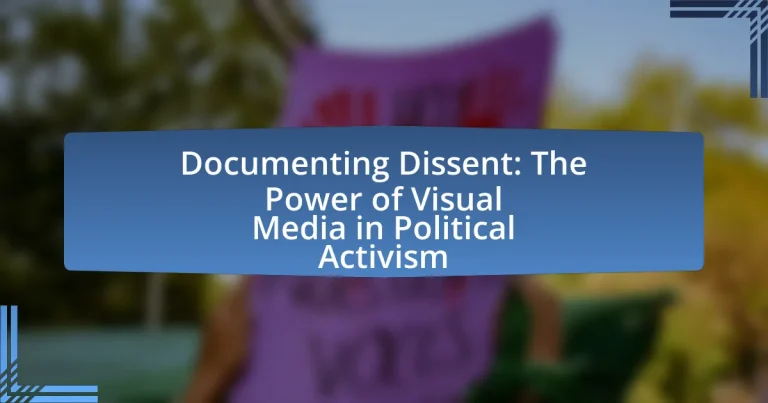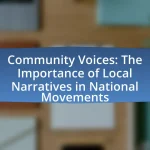The article “Documenting Dissent: The Power of Visual Media in Political Activism” examines the critical role of visual media in capturing and disseminating images and videos that document protests and movements. It highlights how visual media has evolved from traditional formats to digital platforms, enabling rapid information sharing and global engagement. Key historical events, such as the Vietnam War protests and the Arab Spring, illustrate the impact of visual documentation on public perception and political discourse. The article also discusses the challenges activists face, including censorship and misrepresentation, while emphasizing the importance of ethical considerations and best practices in creating visual content. Emerging technologies like virtual and augmented reality are explored for their potential to enhance future activism efforts.

What is the role of visual media in documenting dissent?
Visual media plays a crucial role in documenting dissent by capturing and disseminating images and videos that convey the realities of protests and movements. This form of media serves as a powerful tool for raising awareness, influencing public opinion, and providing evidence of events that may otherwise be ignored or misrepresented by traditional news outlets. For instance, during the Arab Spring, social media platforms like Twitter and Facebook were instrumental in sharing visual content that documented protests, leading to global attention and support for the movements. The immediacy and accessibility of visual media enable activists to communicate their messages effectively, mobilize support, and hold authorities accountable, thereby reinforcing the significance of visual documentation in the landscape of political activism.
How has visual media evolved in the context of political activism?
Visual media has evolved significantly in the context of political activism by transitioning from traditional forms like print and television to digital platforms and social media. This shift has enabled activists to disseminate information rapidly and engage a global audience, exemplified by movements such as the Arab Spring in 2010, where platforms like Twitter and Facebook played crucial roles in organizing protests and sharing real-time updates. The rise of smartphones has further democratized content creation, allowing individuals to capture and share events as they unfold, which has been pivotal in movements like Black Lives Matter, where visual documentation of police brutality has galvanized public support and sparked widespread discourse.
What historical events highlight the impact of visual media on dissent?
The Vietnam War protests in the 1960s and 1970s highlight the significant impact of visual media on dissent. Graphic images and footage of the war, particularly the My Lai Massacre and the Kent State shootings, were broadcast on television and published in newspapers, shaping public perception and fueling anti-war sentiment. The iconic photograph of a Vietnamese girl, Kim Phuc, running from a napalm attack became a symbol of the war’s brutality, galvanizing opposition and leading to increased activism. These events demonstrate how visual media can mobilize public opinion and influence political discourse, ultimately contributing to policy changes regarding military engagement.
How do technological advancements influence the documentation of dissent?
Technological advancements significantly enhance the documentation of dissent by providing accessible platforms for real-time sharing and archiving of events. The proliferation of smartphones and social media enables individuals to capture and disseminate images, videos, and narratives of protests instantly, which can reach global audiences within minutes. For instance, during the Arab Spring, social media platforms like Twitter and Facebook played crucial roles in documenting dissent, allowing activists to share their experiences and mobilize support internationally. This immediate documentation not only raises awareness but also serves as a historical record that can influence public opinion and policy.
Why is visual media crucial for political activism?
Visual media is crucial for political activism because it effectively captures and communicates messages, emotions, and narratives that resonate with audiences. This medium allows activists to convey complex issues quickly and powerfully, often leading to increased engagement and awareness. For instance, studies show that social media posts containing images or videos receive significantly higher engagement rates than text-only posts, highlighting the impact of visual content in mobilizing support and fostering community. Additionally, visual media can document events in real-time, providing evidence of injustices and amplifying marginalized voices, as seen in movements like Black Lives Matter, where videos of protests and police encounters have sparked global conversations and actions.
What psychological effects does visual media have on public perception of dissent?
Visual media significantly influences public perception of dissent by shaping emotional responses and framing narratives. Research indicates that images and videos can evoke strong emotional reactions, such as empathy or outrage, which can lead to increased public support or opposition to dissenting movements. For instance, studies have shown that visual representations of protests can humanize activists and highlight injustices, thereby altering viewers’ perceptions and encouraging solidarity. Additionally, the framing of dissent in visual media can either amplify or diminish its legitimacy; for example, portraying dissenters as violent can lead to public condemnation, while depicting them as peaceful can foster understanding and support. This dynamic is supported by the findings of the Pew Research Center, which found that visual content significantly impacts how audiences interpret social movements and their goals.
How does visual media facilitate the spread of activist messages?
Visual media facilitates the spread of activist messages by providing compelling imagery and narratives that resonate emotionally with audiences. This form of media captures attention quickly, making complex issues more accessible and relatable. For instance, studies show that visual content is processed 60,000 times faster than text, enhancing the likelihood of engagement and sharing on social platforms. Additionally, platforms like Instagram and Twitter have demonstrated that posts with images receive significantly higher interaction rates, amplifying the reach of activist campaigns. The viral nature of visual media allows messages to transcend geographical boundaries, fostering global solidarity and awareness around social issues.

What types of visual media are used in political activism?
Political activism utilizes various types of visual media, including photographs, videos, infographics, posters, and social media graphics. Photographs capture pivotal moments and human emotions, often used in campaigns to evoke empathy and mobilize support. Videos serve as powerful storytelling tools, showcasing events, protests, and personal testimonies that can reach wide audiences. Infographics simplify complex information, making it accessible and engaging, while posters convey messages succinctly and visually, often seen in protests and rallies. Social media graphics leverage platforms like Instagram and Twitter to spread awareness rapidly, with studies showing that visual content is more likely to be shared and engaged with than text alone.
What are the most common forms of visual media in documenting dissent?
The most common forms of visual media in documenting dissent include photographs, videos, infographics, and social media posts. Photographs capture real-time events and emotions, providing a powerful visual narrative of protests and movements. Videos, often shared on platforms like YouTube and social media, allow for dynamic storytelling and can reach a wide audience quickly. Infographics present data and statistics visually, making complex information more accessible and engaging. Social media posts, particularly on platforms like Twitter and Instagram, facilitate immediate sharing and interaction, amplifying the voices of dissenters. These forms of visual media have been crucial in movements such as the Arab Spring and Black Lives Matter, where they have documented events and mobilized support globally.
How do photographs serve as a tool for political activism?
Photographs serve as a powerful tool for political activism by capturing and conveying emotional narratives that can mobilize public opinion and inspire action. They document injustices, human rights violations, and social movements, making abstract issues tangible and relatable. For instance, the iconic image of the 1965 Selma to Montgomery march highlighted the struggle for civil rights in the United States, galvanizing support and leading to legislative changes such as the Voting Rights Act of 1965. Additionally, photographs shared on social media platforms can rapidly disseminate information, reaching a global audience and fostering solidarity among activists. This visual documentation not only raises awareness but also holds authorities accountable, as seen in the widespread sharing of images during the Black Lives Matter protests, which brought attention to systemic racism and police brutality.
What role do videos play in shaping narratives around dissent?
Videos play a crucial role in shaping narratives around dissent by providing visual evidence that can influence public perception and mobilize support. The immediacy and emotional impact of video content allow viewers to witness events in real-time, fostering a sense of urgency and connection to the issues at hand. For instance, footage from protests or police confrontations can highlight injustices, as seen in the widespread dissemination of videos during the Black Lives Matter movement, which significantly impacted public discourse and policy discussions. This visual documentation not only serves as a record of dissent but also empowers activists by amplifying their messages across social media platforms, thereby reaching a broader audience and facilitating collective action.
How do social media platforms amplify visual media in activism?
Social media platforms amplify visual media in activism by providing a rapid and expansive means for sharing images and videos that convey powerful messages. These platforms enable activists to reach a global audience instantly, facilitating the spread of visual content that can evoke emotional responses and raise awareness about social issues. For instance, during the Black Lives Matter movement, images and videos of protests circulated widely on platforms like Twitter and Instagram, leading to increased visibility and engagement with the cause. Research indicates that visual content is more likely to be shared and engaged with than text-based posts, enhancing the overall impact of activism efforts.
What strategies do activists use to maximize engagement on social media?
Activists maximize engagement on social media by utilizing strategies such as creating compelling visual content, leveraging hashtags, and fostering community interaction. Compelling visual content, including infographics and videos, captures attention and conveys messages effectively, leading to higher shares and likes. Hashtags increase the visibility of posts, allowing activists to reach broader audiences and connect with trending topics. Additionally, fostering community interaction through comments, live sessions, and Q&A formats encourages dialogue and builds a sense of belonging among followers, which can enhance engagement metrics. These strategies are supported by research indicating that visual content is 40 times more likely to be shared on social media than other types of content, highlighting the effectiveness of these approaches in driving engagement.
How do algorithms affect the visibility of dissenting voices in visual media?
Algorithms significantly influence the visibility of dissenting voices in visual media by determining which content is prioritized and shown to users. These algorithms often favor mainstream narratives and popular content, leading to the marginalization of dissenting viewpoints. For instance, a study by the Pew Research Center found that social media algorithms tend to amplify content that generates high engagement, which often excludes less popular dissenting opinions. Consequently, dissenting voices struggle to gain traction, as their visibility is reduced in favor of more widely accepted or sensational content.

What challenges do activists face when using visual media?
Activists face several challenges when using visual media, including censorship, misrepresentation, and accessibility issues. Censorship can occur when governments or organizations restrict the dissemination of visual content that challenges the status quo, as seen in various countries where authorities have blocked social media platforms during protests. Misrepresentation arises when visual media is taken out of context or manipulated, leading to distorted narratives that undermine the activists’ message. Accessibility issues also pose a challenge, as not all communities have equal access to technology or the internet, limiting the reach and impact of visual campaigns. These challenges can hinder the effectiveness of activism and the ability to mobilize support.
What risks are associated with documenting dissent through visual media?
Documenting dissent through visual media poses significant risks, including legal repercussions, personal safety threats, and the potential for misrepresentation. Activists and documentarians may face arrest or prosecution under laws that criminalize dissent, as seen in various countries where governments suppress opposition. Additionally, individuals involved in documenting dissent can become targets for violence or harassment from authorities or opposing groups, as evidenced by incidents during protests where journalists and activists have been attacked. Furthermore, visual media can be manipulated or taken out of context, leading to misinformation that undermines the original message, as demonstrated by instances where edited footage has been used to discredit movements.
How can activists protect themselves and their content from censorship?
Activists can protect themselves and their content from censorship by utilizing encryption tools and decentralized platforms. Encryption tools, such as Signal or WhatsApp, secure communications, making it difficult for authorities to intercept messages. Decentralized platforms like Mastodon or PeerTube allow activists to share content without relying on centralized servers that can be easily targeted for censorship. Additionally, using VPNs can help mask online activity and location, further safeguarding against surveillance. These methods have been proven effective; for instance, during the Arab Spring, activists employed encrypted messaging to coordinate protests while minimizing the risk of government monitoring.
What ethical considerations arise in the use of visual media for activism?
The ethical considerations in the use of visual media for activism include issues of consent, representation, and the potential for exploitation. Activists must ensure that individuals depicted in visual media have given informed consent, particularly in vulnerable communities, to avoid violating their privacy and autonomy. Additionally, the representation of marginalized groups must be handled sensitively to prevent reinforcing stereotypes or misrepresenting their experiences. Exploitation can occur when activists use images of suffering without context or respect for the subjects, which can lead to further harm rather than empowerment. These considerations are critical to maintaining ethical standards in activism and ensuring that visual media serves its intended purpose of promoting social justice.
How can activists effectively navigate these challenges?
Activists can effectively navigate challenges by leveraging visual media to document and communicate their messages. Utilizing platforms like social media, activists can share compelling images and videos that resonate with audiences, increasing awareness and engagement. Research indicates that visual content is processed 60,000 times faster than text, making it a powerful tool for conveying complex issues quickly and effectively. Additionally, employing storytelling techniques through visuals can foster emotional connections, encouraging broader support for their causes.
What best practices should activists follow when creating visual content?
Activists should prioritize clarity, emotional impact, and authenticity when creating visual content. Clarity ensures that the message is easily understood, which is crucial for engaging a broad audience. Emotional impact can drive viewer engagement and motivate action, as visuals that evoke strong feelings are more likely to be shared and remembered. Authenticity builds trust and credibility, making the content resonate more with viewers. Research indicates that authentic storytelling in visual media can increase audience connection by up to 50%, highlighting the importance of these best practices in effective activism.
How can collaboration enhance the impact of visual media in activism?
Collaboration enhances the impact of visual media in activism by pooling diverse skills, perspectives, and resources, which leads to more compelling and relatable content. When activists collaborate, they can combine artistic talents, technical expertise, and varied cultural insights, resulting in visual media that resonates with a broader audience. For instance, the collaboration between filmmakers, graphic designers, and grassroots organizations has historically produced powerful documentaries and campaigns that effectively communicate social issues, such as the “Black Lives Matter” movement, which utilized collaborative visual storytelling to amplify its message globally. This synergy not only increases the reach and engagement of the media produced but also fosters a sense of community and shared purpose among activists, ultimately driving greater awareness and action.
What are the future trends in visual media and political activism?
Future trends in visual media and political activism include the increasing use of augmented reality (AR) and virtual reality (VR) to create immersive experiences that engage audiences more deeply. These technologies allow activists to present their messages in compelling ways, making complex issues more relatable and urgent. For instance, organizations like Amnesty International have utilized VR to transport viewers into crisis zones, fostering empathy and understanding. Additionally, the rise of social media platforms continues to democratize content creation, enabling grassroots movements to gain visibility and mobilize support rapidly. According to a 2021 Pew Research study, 69% of U.S. adults reported using social media for political news, highlighting its role in shaping public discourse. Furthermore, the integration of artificial intelligence in content curation is expected to personalize political messaging, making it more effective in reaching targeted demographics. These trends indicate a shift towards more interactive, personalized, and immersive forms of political engagement through visual media.
How might emerging technologies reshape the landscape of dissent documentation?
Emerging technologies are likely to significantly reshape the landscape of dissent documentation by enhancing the accessibility, immediacy, and credibility of information. For instance, advancements in smartphone technology and social media platforms enable individuals to capture and disseminate real-time footage of protests and human rights violations, which can be shared globally within minutes. This immediacy allows for a more dynamic and responsive form of documentation compared to traditional media outlets. Furthermore, technologies such as blockchain can provide immutable records of events, ensuring the authenticity of the documentation and protecting it from censorship or manipulation. The use of artificial intelligence in analyzing large datasets can also help identify patterns of dissent and mobilization, providing deeper insights into social movements. These technological advancements collectively empower activists and organizations to document dissent more effectively, thereby influencing public perception and policy change.
What role will virtual and augmented reality play in future activism?
Virtual and augmented reality will significantly enhance future activism by providing immersive experiences that foster empathy and engagement. These technologies allow activists to create realistic simulations of social issues, enabling users to experience the challenges faced by marginalized communities firsthand. For instance, projects like “The 360-Degree Virtual Reality Experience” have demonstrated how VR can transport users to conflict zones, making the realities of war and displacement more tangible. Research indicates that immersive storytelling can increase emotional responses and motivate individuals to take action, as evidenced by a study published in the journal “Virtual Reality,” which found that participants who experienced VR narratives were more likely to support related causes. Thus, virtual and augmented reality will serve as powerful tools for activism, bridging gaps in understanding and mobilizing support for social change.
What practical tips can activists use to enhance their visual media efforts?
Activists can enhance their visual media efforts by focusing on high-quality imagery, storytelling, and audience engagement. High-quality imagery captures attention and conveys messages effectively; studies show that posts with compelling visuals receive 94% more views than those without. Storytelling through visuals creates emotional connections, making the content more relatable and impactful. Engaging the audience through interactive elements, such as polls or calls to action, increases participation and shares, amplifying the reach of the message. These strategies are supported by research indicating that visual content significantly boosts engagement rates across social media platforms.


